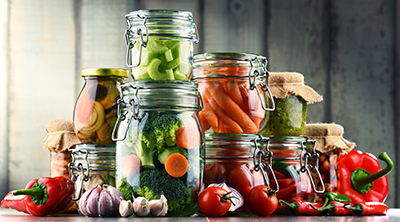Autumn Superfoods
With the arrival of autumn comes the bountiful harvest of nutritious foods. Let’s dive into some health benefits of what’s in season and talk about how to store some of this goodness over the winter.
Pumpkin, Spice, and Everything Nice
Pumpkin is one of autumn’s front runners, and for good reason! The pumpkin flesh is high in vitamins like A, B, C, E, and K; in antioxidants like quercetin; and in minerals like magnesium.[1] Pumpkin flesh can be simply enjoyed roasted or can be puréed for various sweet or savoury dishes. The pulp of the pumpkin is also high in vitamins and minerals and can be added to soups or smoothies. Add a little spice to your smoothie—like cinnamon, nutmeg, clove, and ginger—for a delicious and nutritious pumpkin-spice smoothie!
Pumpkin seeds are an excellent source of various proteins; healthy fats; and elements like zinc, selenium, magnesium, phosphorus, and potassium. These also taste great roasted or can be shelled and added to various dishes or smoothies.
Did you know the pumpkin skin is also edible and nutritious? The skin contains protein, healthy fats, fibre, potassium, and minerals like iron and magnesium. A great way to enjoy these benefits is to make pumpkin-peel chips in the air fryer or dehydrator.
Meet the Rest of the Winter Squash Family
Squash refers to the edible fruit of plants in the gourd family (Cucurbitaceae). These include acorn, spaghetti, delicata, kabocha, butternut, and pumpkin, to name a few. Squash is typically classified as summer or winter depending on its harvest time and storage life. With so many winter varieties available right now, there are endless ways to reap the health benefits of these gourds, which have many overlapping health benefits and similar nutrients as pumpkin. What differs are their flavour profiles and how they can be enjoyed. The recipes are endless: Mashes, roasted, soups, and stews are among my favourites.
Rooting for Root Veggies
There’s no mystery here: Root vegetables are those that grow underground. These include beets, turnips, potatoes, radishes, sweet potatoes, carrots, and parsnip. Did you know that even celery root (aka celeriac) is nutritious—and delicious? These root vegetables can be enjoyed raw in salads or cooked in soups or stews. Celeriac makes a great mash and is one of my favourite Thanksgiving side dishes.
Root vegetables are rich in vitamins, minerals, and fibre. They also store well over winter in a cool, dark, damp place like a basement or root cellar, so you can enjoy their benefits all winter long without too much extra effort.
An Apple a Day Keeps the Doctor Away
There is some merit to the saying. This hydrating fall fruit supports the immune system, digestion, and the heart with all if its vitamin C, antioxidants, and fibre. In Canada, there are over 100 commercially grown apple varieties to choose from, and they can be eaten raw with minimal preparation. It’s important to note, however, that apples are on the Environmental Working Group’s Dirty Dozen list for pesticide content,[2] so it is best to opt for organic and to wash the fruit before eating or cooking to avoid harmful pesticides.
Apples are another autumn superfood and, depending on the variety, some stay hard and crisp over the winter when stored in a cool, dark, dry place like the refrigerator. Others are particularly suited for juicing, baking, cooking, canning, or freezing.

Canning, Dehydrating, or Freezing for Winter Storage
Canning and freezing are both great options for having access to nutrient-dense foods throughout winter. Canning also has the added benefit of bringing a source of probiotics into your diet over the winter. If you are new to canning, it is important that you first learn about food safety and safe canning techniques. Find some trustworthy resources online, in books, or even from someone you know who has experience with safe canning methods.
From the superfoods we discussed today, puréed pumpkin, apple sauce, or apple cider are great options for a beginner canning project. All of these can also be frozen over the winter in airtight containers and thawed when ready to use. Another great idea is to make soups and stews in the fall and freeze them so that they are ready to go on cold winter nights!
Dehydrating is another simple and effective option: It removes moisture to extend shelf life while preserving nutrients and flavour. Apple slices, fruit leather, squash, or even root vegetables like carrots and beets can be dehydrated for snacks, soups, or baking. Store dried foods in airtight containers in a cool, dark place for best results.
Many of the vegetables we talked about today—like the squash, root vegetables, and apples—also naturally have a long shelf life if stored properly, making them available through the winter months.
There you have it! Some front-runner superfoods for the season. What is your favourite autumn superfood?

Dr. Felicia Assenza, HBSc, ND
A Hamilton-based naturopathic doctor whose goal in every patient visit is to share the knowledge and experiences that she gained on her own journey.
drfeliciaassenzand.com
References
[1] Batool, M., M.M.A.N. Ranjha, U. Roobab, M.F. Manzoor, U. Farooq, H.R. Nadeem, M. Nadeem, et al. “Nutritional value, phytochemical potential, and therapeutic benefits of pumpkin (Cucurbita sp.).” Plants, Vol. 11, No. 11 (2022): 1394.
[2] [No author listed.] “The 2025 Dirty Dozen™.” EWG’s Shopper’s Guide to Pesticides in Produce. Available from https://www.ewg.org/foodnews/dirty-dozen.php · [No date given.] Accessed 2025‑05‑16.

